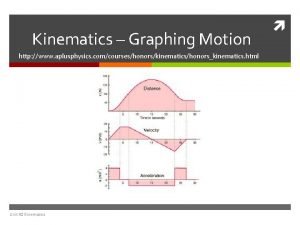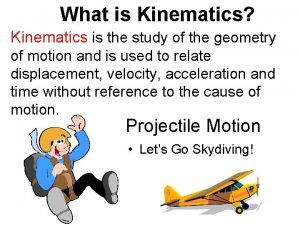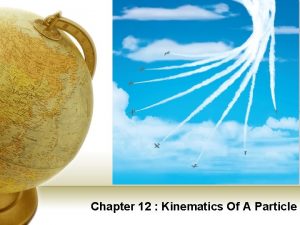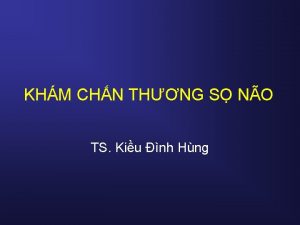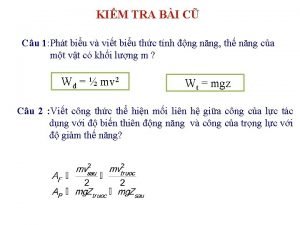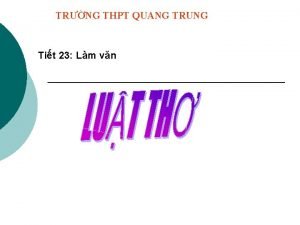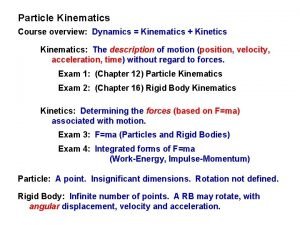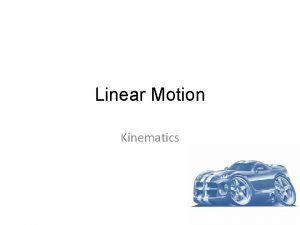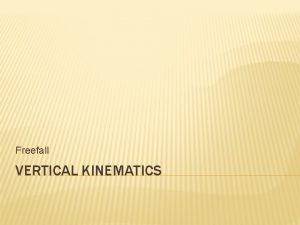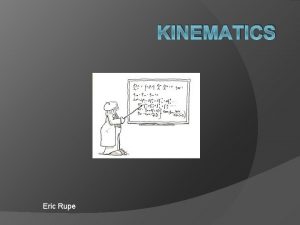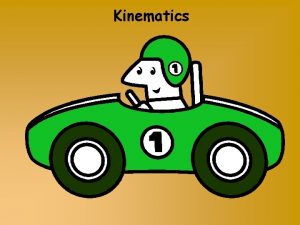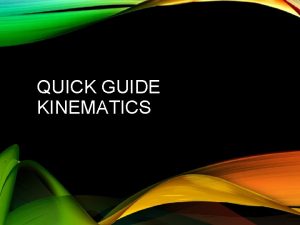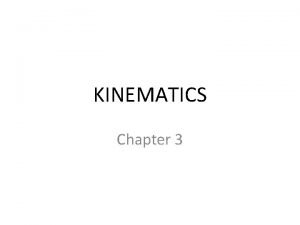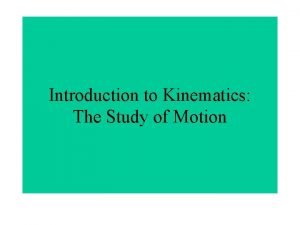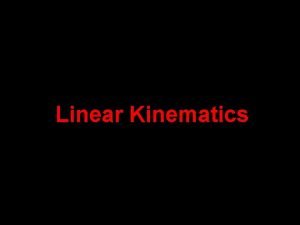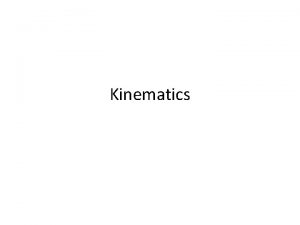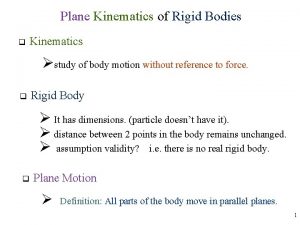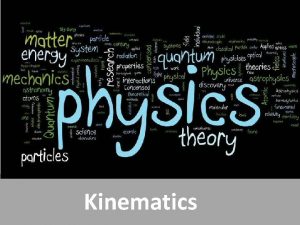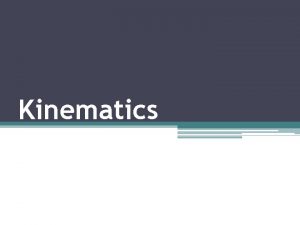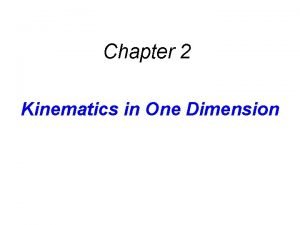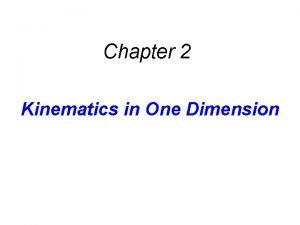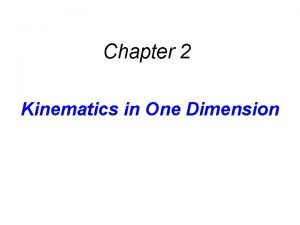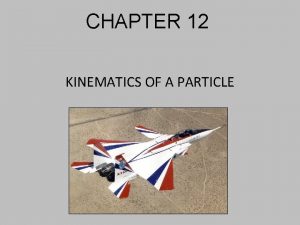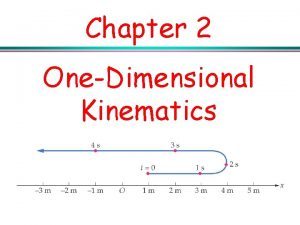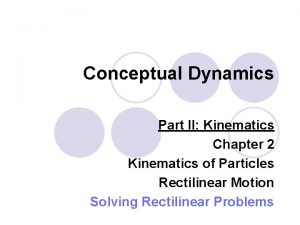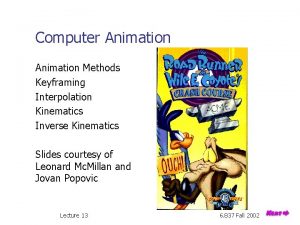Chapter 2 1 Kinematics Kinematics is the study























- Slides: 23

Chapter 2. 1 Kinematics

• Kinematics is the study of motion • Distance is a measure of length only • Displacement is the distance traveled in a particular direction from a specified origin. • Displacement is a vector quantity. A negative sign denotes direction to the left of the origin and a positive sign denotes direction to the right.

• • • s= distance x= displacement (straight line) r= displacement in more than one dimension Example 1: S= total distance traveled Delta x= final displacement-initial displacement (change in displacement)

• Example 2: An object has a displacement of -5 m. It moves a distance to the right equal to 15 m and then a distance of 10 m to the left. What is the total distance travelled and final displacement of the object? What is the change in displacement of the object?

• Avg speed= distance/total time • Example 3: • Instantaneous Speed= distance covered in a very short instance of time • Example 4: Car travels 4. 2 m, takes. 56 s to go past a mark on the road. What is the speed of the car?

Velocity • Speed doesn’t take into account direction, velocity does. • Average velocity • Instantaneous velocity (can be + or -)

• Example 5: Car starts out 100 km to the right of the origin. It moves a distance of 20 km to the right and returns to its starting position 1 hour later. What is the average speed and average velocity for this trip?

• Uniform velocity (or uniform motion) is motion in which velocity is constant. This means the displacement changes by equal amounts in equal intervals of time. • Constant velocity equation

• Example 6: Bicyclist A has initial displacement =0 and moves with velocity 3 m/s. At the same time, bicyclist B starts from a point with displacement 200 m and moves with a velocity -2 m/s. When does A meet B and where are they when this happens?

• Example 7: Object A starts from origin with velocity of 3 m/s. Object B starts from the same place with velocity of 5 m/s 6 seconds later. when will B catch up with A?

Graphs of Uniform Motion Object is at rest not moving Moving at constant speed (slope of line is constant) Accelerating Decelerating Displacement graphs can be above or below the x-axis The slope or gradient of a distance-tine graph gives the speed. Slope or gradient for a displacement-time graph gives the velocity. • To find instantaneous velocity draw a tangent line to the slope of the curve • • •

Velocity vs. Time Graph • From 0 to A, object moving at constant acceleration. • From A to B, object moving at constant speed. • From B to C, object is decelerating at constant acceleration and at point C, it comes to a stop. • Gradient of a velocity-time graph gives acceleration. • The area under a velocity-time graph gives the displacement.

Acceleration vs. Time Graph • If acceleration is uniform or constant, then these graphs will simply be vertical and horizontal straight lines. • From 0 to A constant acceleration • From A to B zero acceleration • From B to C constant deceleration • Area under acceleration-time graph gives change in velocity.

Frames of Reference-Relative Velocity • The velocity can be different depending on who is observing the motion. • Consider 3 different frames of reference 1. Observer A is on the ground 2. Observer B is a passenger in a train sitting in her seat. 3. Observer C is a passenger on a train who walks in the direction of motion of the train at 2 m/s as measured by a passenger sitting in her seat.

• Train moves in a straight line with constant velocity 10 m/s as measured by observer on the ground. Situation is different for each observer: From A’s perspective: 1. A says he is at rest 2. B moves forward at 10 m/s 3. C moves forward at 12 m/s

• From observer B’s perspective: 1. B is at rest 2. A is moving backwards at -10 m/s 3. C is moving at 2 m/s • From observer C’s perspective: 1. C is at rest 2. A is moving backwards at -12 m/s 3. B is moving at -2 m/s

• Example 8: Car A moves left with speed 40 km/hr wrt road. Car B moves right with speed 60 km/hr wrt road. Find relative velocity of B wrt A. • Example 9: add an example problem of relative velocity in 2 dimensions.

Motion with Constant Acceleration • Acceleration is needed for situations in which velocity is not constant. • Instantaneous acceleration equation • In cases of constant acceleration, instantaneous acceleration and average acceleration are the same.

Kinematics Equations • Can only be used in the case of constant acceleration. • Example 9: object has initial velocity of 2. 0 m/s and has constant acceleration. After 5 s its velocity is 12. 0 m/s. What is the acceleration? • For motion in a straight line, positive acceleration means velocity is increasing, while negative acceleration means decreasing velocity (not speed)

Acceleration Due to Gravity • Neglect air resistance for now • When an object is dropped or thrown, its acceleration is gravity=9. 8 m/s 2=g in a vacuum. • Consider a body falling freely under gravity. Upward direction is positive velocity. On the way up, velocity is decreasing, so acceleration due to gravity is negative. • Draw free body diagrams of acceleration due to gravity.

• If you have constant acceleration, you can use the equations to solve many different types of problems. • Example 10: What is the displacement after 10 s of a mass whose initial velocity is 2 m/s and moves with acceleration of 4 m/s 2?

• Example 11: A car has initial velocity of 5 m/s. When its displacement increases by 20 m, its velocity becomes 7 m/s. What is the acceleration? • Example 12: A mass is thrown upwards with an initial velocity of 30 m/s. A second mass is dropped from directly above, a height of 60 m from the first mass, . 5 s later. When do the masses meet and how high is the point where they meet?

Measuring Speed and Acceleration • Measuring speed with a photogate • Measuring speed with tickertape- instrument that makes marks on a paper tape at regular intervals of time. You can divide by each distance the set time to get speed and use it to determine if it is constant speed, accelerating, etc. • Do experiment with tickertape.
 Aplusphysics kinematics-horizontal kinematics
Aplusphysics kinematics-horizontal kinematics Kinematics is the study of
Kinematics is the study of Kinematics of a particle
Kinematics of a particle Hình ảnh bộ gõ cơ thể búng tay
Hình ảnh bộ gõ cơ thể búng tay Slidetodoc
Slidetodoc Bổ thể
Bổ thể Tỉ lệ cơ thể trẻ em
Tỉ lệ cơ thể trẻ em Voi kéo gỗ như thế nào
Voi kéo gỗ như thế nào Tư thế worm breton
Tư thế worm breton Alleluia hat len nguoi oi
Alleluia hat len nguoi oi Các môn thể thao bắt đầu bằng tiếng đua
Các môn thể thao bắt đầu bằng tiếng đua Thế nào là hệ số cao nhất
Thế nào là hệ số cao nhất Các châu lục và đại dương trên thế giới
Các châu lục và đại dương trên thế giới Công của trọng lực
Công của trọng lực Trời xanh đây là của chúng ta thể thơ
Trời xanh đây là của chúng ta thể thơ Cách giải mật thư tọa độ
Cách giải mật thư tọa độ Phép trừ bù
Phép trừ bù Phản ứng thế ankan
Phản ứng thế ankan Các châu lục và đại dương trên thế giới
Các châu lục và đại dương trên thế giới Thơ thất ngôn tứ tuyệt đường luật
Thơ thất ngôn tứ tuyệt đường luật Quá trình desamine hóa có thể tạo ra
Quá trình desamine hóa có thể tạo ra Một số thể thơ truyền thống
Một số thể thơ truyền thống Cái miệng nó xinh thế
Cái miệng nó xinh thế Vẽ hình chiếu vuông góc của vật thể sau
Vẽ hình chiếu vuông góc của vật thể sau
